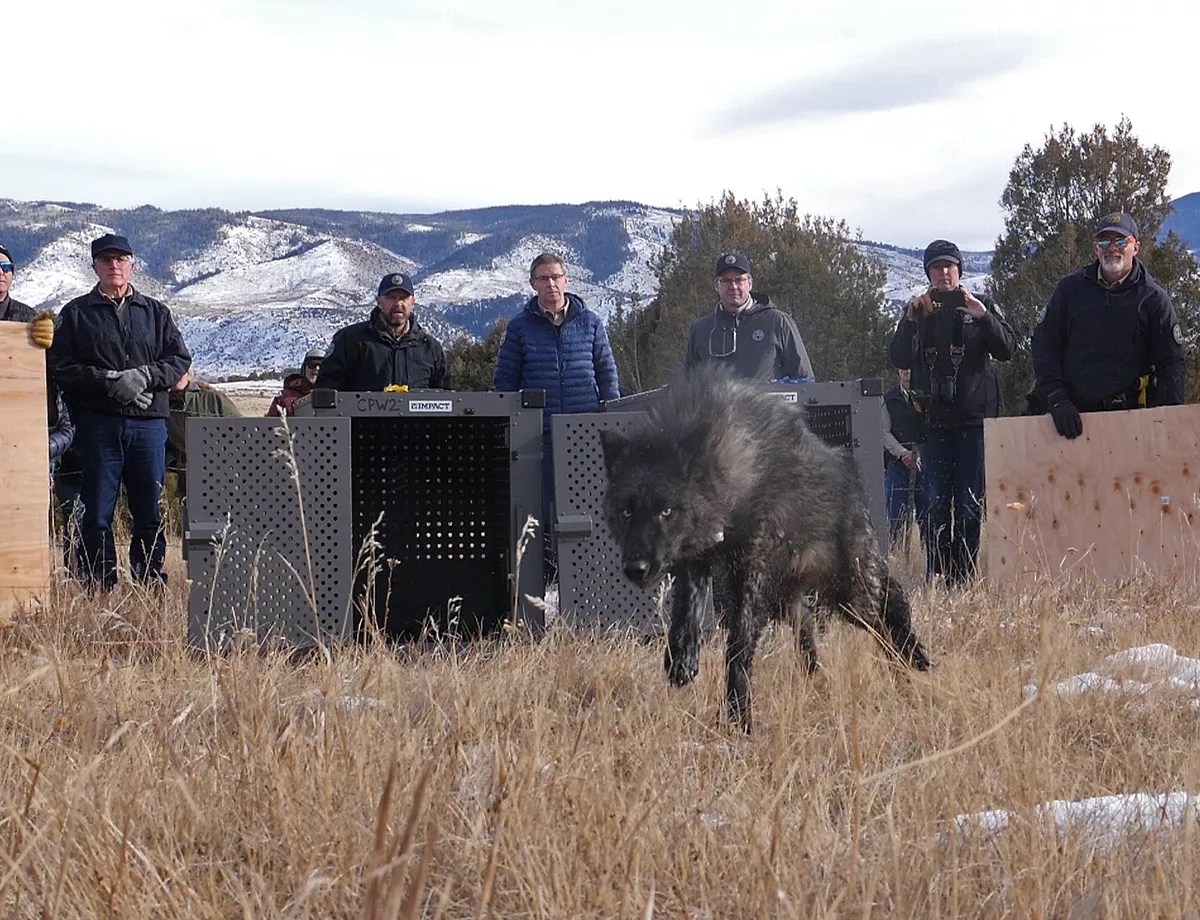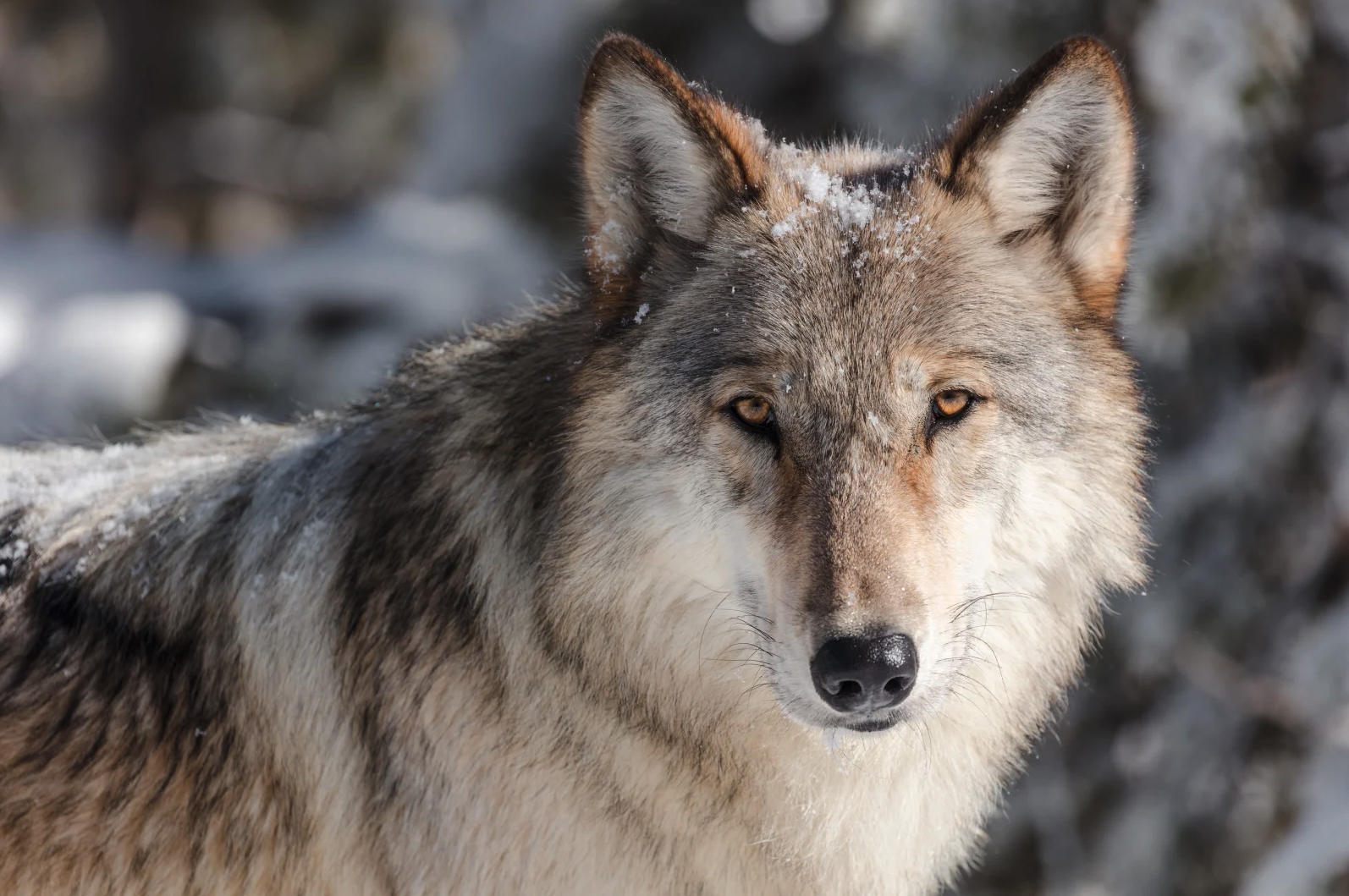
Endangered Species Coalition

Audio By Carbonatix
On December 18, 2023, Governor Jared Polis opened a crate containing the first wolf to be released in Colorado, after voters had approved the reintroduction of the species in November 2020.
It was a joyous occasion for environmental groups that had fought for reintroduction for years – and for the wolf itself, which bounded up a nearby hill. But the topic remains a hot one, as plenty of Coloradans still don’t want wolves to re-enter the state’s landscape, particularly agricultural producers on the Western Slope.
According to Colorado Parks and Wildlife, wolf reintroduction has gone well, and the agency is planning more releases in 2025. But the end of last year was marked by both livestock and wolves dying, and state lawmakers were discussing pausing the program to make up for budget shortfalls.
In fact, agricultural producers have submitted a petition to CPW asking that reintroduction be halted. Although CPW staff recommended denying the petition, commissioners will have the final say, with a vote slated for their January 8-9 meeting. But no matter what the commissioners decide, a petition to repeal wolf reintroduction is now working its way to the 2026 ballot.
When news happens, Westword is there —
Your support strengthens our coverage.
We’re aiming to raise $50,000 by December 31, so we can continue covering what matters most to this community. If Westword matters to you, please take action and contribute today, so when news happens, our reporters can be there.
With a full year now on the books, here’s a look back at wolf reintroduction in Colorado:
Wolf Numbers in 2024
The 2020 voter-approved initiative required CPW to begin reintroducing wolves in Colorado by the end of 2023. By December 20, 2023, CPW had moved ten gray wolves from Oregon to public land in Summit and Grand counties.
Since then, wolves have been tracked in watersheds touching nine Colorado counties: Rio Blanco, Garfield, Eagle, Pitkin, Lake, Summit, Grand, Routt and Jackson. CPW tracks with GPS monitors but doesn’t release live or exact locations to preserve privacy and safety for the wolves, and notes that just because wolves have been in part of a watershed doesn’t mean they’ve been in all of that territory.
Two wolves mated to form what wildlife officials call the Copper Creek Pack, while the others are described as wandering around the state. Another wolf pack had already roamed down from Wyoming into Colorado in 2023, according to CPW, so there were officially two packs in Colorado during 2024. While one pair mated and produced four known pups, three Colorado wolves died in 2024.
According to CPW, one wolf died after fighting a mountain lion, and another died in September after an interaction with another wolf. The male of the Copper Creek Pack died in CPW custody this fall, after the wildlife agency had captured the entire pack to try to mitigate their propensity for preying on livestock near Kremmling. CPW officials said the wolf already had a leg injury when it was captured and subsequently died from that injury, but the wolf also sustained a gunshot wound in a separate incident. (A major award has been offered for information about the shooting.)
Confirmed Livestock Depredations
When wolves interact with livestock in a manner that leads to injury or death, that is considered wolf depredation. In Colorado, agricultural producers reported seventeen confirmable incidents to the state after wolves were reintroduced.
In Grand County, eight confirmed incidents occurred between April and September, with six cows or cattle involved, along with three calves and nine sheep impacted; CPW did not specify where the eight incidents resulted in death or injuries.
In Routt County, four incidents occurred in June and July. All four were related to wolves preying on calves.
From April through June, four depredation incidents took place in Jackson County. Again, each resulted in the death of a calf.
Finally, Elbert County saw one confirmed incident on March 15, when a llama fell prey to wolves.
According to the Middle Park Stockgrowers Association, though, the confirmed depredations aren’t even the tip of the iceberg. On December 31, Tim Ritschard, president of the association, wrote a letter to the CPW commissioners detailing a newly submitted claim by three ranchers saying that the state should pay them over $500,000 for wolf-related losses.
Money Paid for Lost Livestock
After a depredation incident is confirmed, the owners of lost livestock can submit claims to the state for reimbursement. CPW calculates the fair market value of the animal, with a cap of $15,000.
To pay for those deaths, the Colorado Legislature established a Wolf Compensation Depredation Fund, which received $175,000 from the state general fund in its first year and is set to receive $350,000 annually going forward.
Despite the seventeen confirmed incidents, only four people submitted official claims for reimbursement in 2024. So far, CPW has paid three of those people. In Routt County, compensation for one calf was $1,141.17, and in Jackson County, CPW paid $1,514 for a calf. In Elbert County, CPW awarded $1,200 for the llama incident.
But according to Ritschard’s letter to the commission, three ranchers believe they deserve far more in compensation: $18,411.71 for the death or injury of sheep and cattle, $515 in veterinarian costs for a calf necropsy, $173,526.63 for missing livestock, $218,220.98 for reduced weight of livestock, and $172,754.64 for reductions in births at ranches with confirmed wolf attacks or kills.
CPW expected an uptick in claims in December, as people had until the end of the calendar year to submit claims for anything that occurred in 2024. But the legislature’s Joint Budget Committee didn’t wait until year’s end to suggest cuts to the Wolf Depredation Fund in order to help fix the state’s budget gap. The JBC suggested decreasing the amount for future years to $175,000 instead of increasing the appropriation, as originally planned.

The debate over wolves didn’t end when paws hit the ground.
Jacob Frank/NPS
State Budget Puts Program at Risk
The JBC is trying to decrease the state budget by nearly $1 billion. CPW only spent $1.57 million of the $2.1 million appropriation for wolf reintroduction in the 2023-2024 fiscal year; if the program were paused, it would save even more.
CPW would still monitor the existing wolf population, as it did before that pack wandered down from Wyoming. However, no more wolves would be brought in from other locations, and funding for wolf-livestock conflict minimization would decrease. Proponents of the pause argue that the statute established no deadline to achieve a self-sustaining wolf population, so as long as the state eventually picks the project back up, it would be legally allowed.
Environmental groups urged the JBC not to cut spending, with twelve conservation groups signing a letter headlined by the Rocky Mountain Wolf Project, a key player in pushing for Colorado wolf reintroduction.
“Cutting funds at this critical juncture would not only contradict the will of Colorado voters but would also prove fiscally and biologically irresponsible,” the letter reads. “Colorado has already invested significant resources in planning, public outreach and initial wolf releases. Cutting funding now would waste these investments and potentially require even greater expenditures in the future to restart the program.”
The letter notes that CPW’s progress on establishing more wolf-livestock conflict reduction programs would cost money up front but pay dividends in success. And it also points out that voters approved reintroduction until the state has a “self-sustaining” population of wolves, which requires many more than the dozen that are in the state now.
In contrast, the petition submitted by agricultural producers argues for a range rider program, better carcass management and site vulnerability assessments from CPW, as well as a rapid response team for depredations in place before any more wolves are brought to the state. Site assessments identify places where ranchers could improve their property’s protections against wolves, while range riders are basically shepherds who know specifically how to deter wolves from herds. Producers want better instructions on how to deal with the carcasses of dead animals so as not to attract wolves.
On December 9, CPW and the Colorado Department of Agriculture announced that they are implementing responses to all those asks in preparation for more wolf releases in 2025. CPW has hired five wildlife damage experts and plans to hire five more, and has also hired a Non-Lethal Conflict Reduction Program Manager; the CDA has added two mitigation specialists, as well.
The two organizations have partnered to create a Colorado Range Rider program that will launch this year; the program will deploy personnel to visit livestock and deploy hazing techniques to deter wolves.
“CPW staff and our partners have been working hard, learning and adapting throughout this first year of wolf restoration in Colorado,” CPW head Jeff Davis said in the announcement. “We take our responsibility for the well-being of the ranchers, their livestock and the wolves very seriously. We are confident we will be successful restoring a healthy, sustainable population of gray wolves to Colorado as mandated while avoiding and minimizing impacts to our critical ranching industry and rural communities.”
CPW plans to release wolves in Garfield, Eagle or Pitkin counties in 2025. After facing some challenges securing wolves for the first round of introduction, the agency will use wolves from British Columbia this time and plans to integrate the mother and pups from the Copper Creek Pack, which are still in custody with the Canadian wolves.